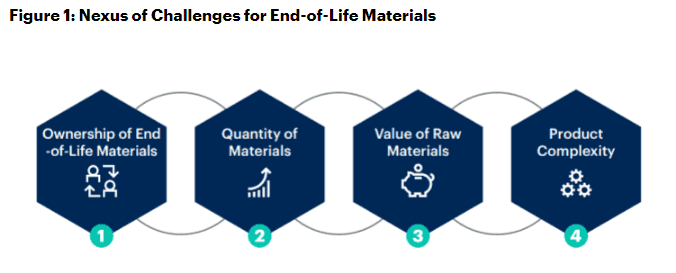A variety of factors are likely to increase adoption of circular economy practices, a new report from the analysts at Gartner.
Greatly simplifying, the idea underlying the circular economy concept is that re-use and recycling of goods become the norm, versus the current "take-make-dispose" paradigm.
Supply Chain Digest Says... |
 |
| Poorly designed products with toxic materials can be incredibly difficult and costly to process and put back into the market," Watt observed in the research note. |
 |
What do you say? |
| Click here to send us your comments |
 |
| Click here to see reader feedback |
|
|
In 2019, Gartner predicted that circular economies would replace linear economies in 10 years. (See Gartner Says Circular Economy will be Dominant in Decade.)
Now the research firm has just announced results from a new survey that found 51% of supply chain professionals expect that the focus on their circular economy strategies will increase over the next two years.
The survey of 528 supply chain professionals found two main drivers for the expected rise in focus.
(1) Consumers may not be willing to make big purchases, resulting in product as a service (PaaS) models becoming more attractive. With PaaS, the user does not actually buy the product – say a lawn move – but rather rents or leases it from a manufacturer or distributor, and must give it back after some period of time, perhaps enhancing recycling/re-use programs.
(2) A circular economy has the potential to improve raw material security from end of life products. Chief supply chain officers (CSCOs) can use circular economy strategies to increase their organization's raw material security in times of disruption, as companies can leverage materials in items they have made in the past but are now being returned.
"The COVID-19 pandemic has shown that the strengths of globalized supply chains can become a weakness when raw material availability and access plummet during a crisis," said Sarah Watt, senior director analyst with the Gartner. "For CSCOs, the circular economy is a great opportunity to improve raw material resilience and decouple material consumption from financial growth."
But circular practices are not easy, facing a variety of challenges, as shown in a graphic from the Gartner report below:

Gartner then provides some more detail on each these challenges:
Ownership of End-of-Life Materials
Most supply chain organizations lose control of products and raw materials at their respective point of sale. This means that they must re-gain access from the consumer at the end of a product's life. High-tech organizations favor leasing and subscription models because the product will automatically return to them.
Quantity of Materials
One of the key challenges is to collect and centralize end-of-life products for processing in an economical fashion. Most supply chain organizations collaborate with waste vendors, raw material suppliers and reverse logistics providers to gain access to material.
Value of Raw Materials
A circular economy still needs to operate within economic boundaries. Products with low residual value are less likely to be processed. While there may be differences in environmental impacts between materials, most of the organization's decision-making will be based on economics and risk.
(Article Continued Below)
|
CATEGORY SPONSOR: SOFTEON |
|
|
| |
|
|
Product Complexity
The less complex a product, the easier and cheaper the reprocessing. One of the easier methods to overcome complexity is by recycling to reclaim primary materials. However, recycling leads to loss of value, as the manufactured product is being extinguished in the process.
Only 24% of survey respondents stated that their organization is involved in refurbishment activities. Refurbishment provides more value than recycling as it typically reduces environmental impact and allows the organization to achieve a quick second sale.
"Product design is crucial to end-of-life management. Poorly designed products with toxic materials can be incredibly difficult and costly to process and put back into the market," Watt observed in the research note.
SCDigest wonders whether business or consumers will take to a model where they do not own and must return the products they once purchase. The easy answer: Yes, if there is a financial incentive to do so.
Do you expect circular practice to grow? How rapidy? Let us know your thoughts at the Feedback section below.
Your Comments/Feedback
|